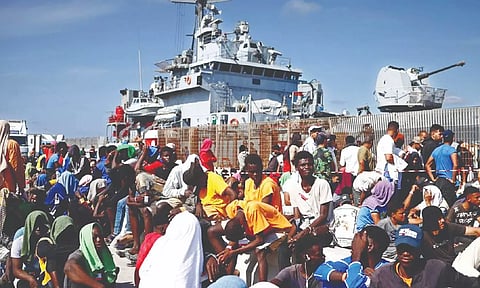

• BERND RIEGERT
On Sunday, Italian Prime Minister Giorgia Meloni and European Union Commission President Ursula von der Leyen planned to visit the Italian island of Lampedusa where thousands of migrants arrived this week from Tunisia. Meloni said in a video on Friday evening that Italy needs the EU’s help to handle the emergency. “The migratory pressure Italy has been experiencing since the beginning of the year is unsustainable,” said the far-right politician. As images of chaotic conditions on the island spread, she is under pressure to deliver on a campaign promise to end migration.
For years, Italy has been receiving personnel and financial support from the EU for the operation of reception centers and registration points, called “hot spots.” But nearly 126,000 migrants have arrived in Italy this year, almost double the figure by the same date in 2022. More than 2,000 have died on the treacherous crossing between North Africa and Europe, according to the UN migration agency. Meloni wants the issue of migration to be added to the agenda of the next EU summit in October. In her video message, she called for an EU mission to prevent boats from leaving Tunisia.
But such a measure would violate international maritime law, as neither Italian nor other EU ships are allowed to operate in the 12-mile territorial zone off the Tunisian coast, where that country alone has jurisdiction. Even outside this zone, EU naval vessels would not be allowed to intervene at all as long as boats carrying migrants are seaworthy.
Nor can Italy permanently prevent boats from docking in its ports, though authorities there can initially deny access to seaworthy boats for safety reasons and assign them to other ports. Shipwrecked people on rescue boats must be assigned a safe port by the Italian rescue coordination center in Rome, though this port may be far away in northern Italy. Since the beginning of the year, the Italian government has been trying to make it more difficult for private rescue ships to operate. In practice, this has had little effect on the number of arrivals; according to the coast guard, about 90% of migrants make the crossing on their own, landing somewhere inside or outside a port in Italy.
There have been several joint EU maritime missions under Italian leadership in recent years: Mare Nostrum, Triton and Sophia. The most recent was discontinued in 2020 at the request of the Italian government, which said the mandates, which initially included sea rescue, went too far.
There are few details as to how Meloni, who took office last fall, envisions the new naval mission she has called for.
Meloni, von der Leyen and Dutch Prime Minister Mark Rutte visited Tunisia in July, after which they announced a migration deal with the Tunisian president. Currently the main transit country for migrants leaving North Africa on boats, Tunisia is to prevent refugees from crossing to Europe in return for economic aid of around 1 billion euros ($1.07 billion).
But whether and how this will actually happen remains unclear, especially since Tunisian President Kais Saied declared a couple of weeks later that his country would not serve as the EU’s refugee camp.
Meloni’s call for the EU’s “New Pact on Migration and Asylum” to be implemented as soon as possible is something that von der Leyen would likely agree with. In her speech on the state of the EU in the European Parliament in Strasbourg on Wednesday, she advocated for finally adopting the measures, which the European Commission has been proposing for years. EU interior ministers have, however, been unable to reach a consensus on the final provisions.